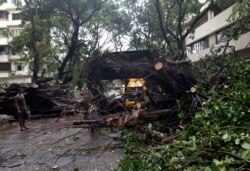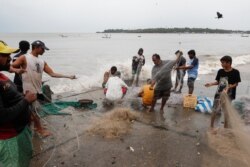A cyclone pounded India’s west coast on Wednesday, sending tens of thousands of people in coastal villages and in low-lying slums in the country’s financial capital, Mumbai, to seek safer sanctuary. There was major relief, though, as the country’s financial capital escaped the wrath of the storm.
As Cyclone Nisarga roared in from the Arabian Sea packing winds of more than 120 kilometers per hour, the biggest worries had centered on the preparedness of Mumbai, a city of 20 million people, which had not experienced a storm of this intensity in more than 70 years.
The densely packed city — where tall buildings contrast with tin-roofed shanties in sprawling slums — experienced dark skies, heavy rains and strong, gusty winds for much of the day, but it suffered little damage, according to authorities.
The Indian Meteorological Department said Wednesday evening that the storm was moving away and no longer posed a threat to the city.
Authorities in Mumbai said no health facilities were damaged. Ahead of the cyclone, concerns were high about the impact the storm may have on the infrastructure in a city that is struggling to cope with the highest number of COVID 19 cases in the country — its more than 40,000 cases account for about one-fifth of India’s total numbers.
More than 150 patients suffering from COVID 19, who were being treated at a makeshift hospital in the city, were among thousands evacuated ahead of the storm.
Several flights from Mumbai were canceled and the country’s largest container port on its outskirts was ordered shut for 24 hours.
Virtually all of the city’s residents adhered to Maharashtra Chief Minister Uddhav Thackeray’s call to stay at home.
“We charged our phones, we filled up water in case supplies were disrupted, and we shut all windows, and we were concerned about power outages, but there was no disruption,” says Geetanjali Prasad, a city resident.
Ahead of the cyclone, the government had urged people along the coast on the western states of Maharashtra and Gujarat to secure homes, prepare an emergency kit, and keep valuables in water-proof containers.
In the coastal town of Alibaug, where the storm first hit, visuals shared by India’s Disaster Response Force showed overturned carts, fallen trees and tin roofs of coastal homes ripped apart.
The cyclone on India’s west coast comes on the heels of another powerful storm which killed more than 100 people when it hit eastern India and Bangladesh two weeks ago.
The cyclones have tested India as it witnesses huge spikes in coronavirus cases — the number of COVID 19 patients has risen three times in the past three weeks, to upwards of 200,000 cases, and nearly 6,000 deaths.
Officials have warned the surge will continue for some time. “We are very far away for the peak,” according to Nivedita Gupta, of the government-run Indian Council of Medical Research.
Health officials say the numbers are bound to rise as the country slowly opens its economy and eases one of the world’s most stringent lockdowns.










